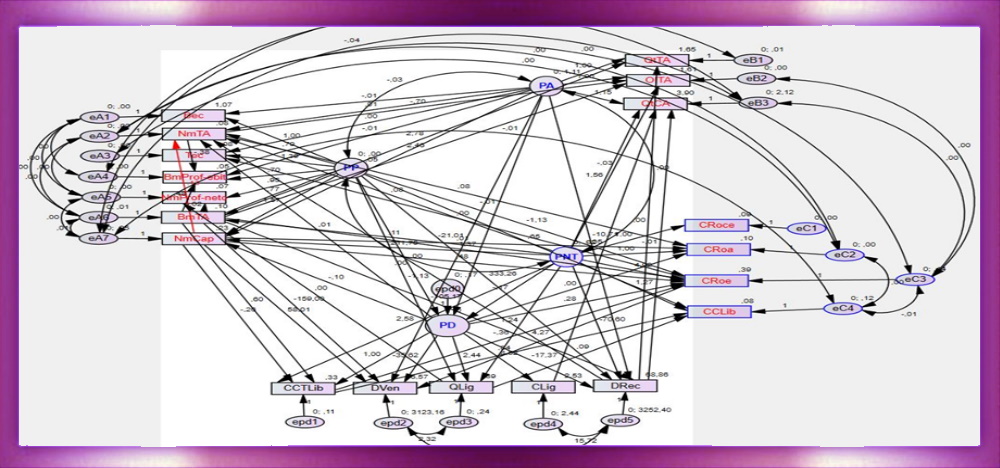ØGoodness of fit Index (GFI)
The RMR, GFI table can be found under: View → Text Output → Model fit → RMR, GFI
RMR, GFI |
||||
|
Model |
RMR |
GFI |
AGFI |
PGFI |
|
Default model |
0,148 |
0,963 |
0,978 |
0,623 |
|
Saturated model |
0 |
1 |
||
|
Independence model |
0,152 |
0,545 |
0,643 |
0,324 |
v RMR
RMR = Root Mean Square Residual.
Reference values for RMR (Root Mean Square Residual) depend on the size of the model, the number of variables, and the values of other fit indices. There is no one specific set of reference values that can be universally applied, as different studies may have different expectations for what constitutes an acceptable level of RMR.
|
Interpretation:
|
|
|
A value RMR = 0 represents a perfect fit. |
|
|
A value RMR <0,05 indicates an acceptable fit |
|
|
RMR ≤ 0.05 = acceptable fit |
Diamantopoulos & Siguaw , 2000 |
|
RMR ≤ 0.07 = acceptable fit |
Steiger, 2007 |
|
Some commonly used thresholds for RMR include values less than 0,08 or less than 0,05 |
Hu & Bentler, 1999; Kline, 2016 |
|
The smaller the RMR value the better. |
|
|
|
www.StatistischeBeratung.de |
It is important to note that these thresholds are not absolute and should be considered in conjunction with other fit indices when evaluating model fit.
RMR are 0,148 for our tested (default) model.
v GFI *
GFI stands for Goodness of fit Index and is used to calculate the minimum discrepancy function necessary to achieve a perfect fit under maximum likelihood conditions (Jöreskog & Sörbom, 1984; Tanaka & Huba, 1985). The Goodness of fit Index (GFI) is a measure of how well the model fits the data, with values ranging from 0 to 1.
GFI = Goodness of fit Index and takes values of ≤ 1.
|
Interpretation:
|
|
|
A value GFI = 1 represents a perfect fit. |
|
|
Higher values indicate a better fit. |
|
|
A value GFI ≥ 0,9 indicates a reasonable fit |
Hu & Bentler, 1998 |
|
values above 0,90 indicate a good fit |
Hair, Anderson, Tatham, and Black, 1998 |
|
A value GFI ≥ 0,9 indicates a reasonable fit |
Homburg/Baumgartner, 1988, S.363 |
|
A value GFI ≥ 0,95 is considered an excellent fit |
Kline, 2005 |
|
suggests that values between 0,90 and 0,95 are acceptable fit and values above 0,95 are excellent fit |
Kline, 2016 |
|
|
www.StatistischeBeratung.de |
GFI are 0,963 for our tested (default) model, this is considered an excellent fit.
v AGFI
AGFI = Adjusted Goodness of fit Index and indicates the degree of freedom (df) for testing the model. A value of 1 indicates a perfect fit. Unlike GFI, AGFI values do not stop at 0.
The reference values for AGFI (Adjusted Goodness of fit Index) may vary depending on the specific research field and the complexity of the model. It is important to note that these are general guidelines and the specific threshold for an acceptable fit may vary depending on the research context and the complexity of the model.
|
Interpretation:
|
|
|
A value AGFI = 1 represents a perfect fit. |
|
|
A value AGFI ≥ 0,9 indicates a reasonable fit |
Bagozzi/Yi, 1988, S.82 |
|
A value AGFI ≥ 0,9 indicates a acceptable fit |
Tabachnick & Fidell, 2007 |
|
AGFI values greater than 0,90 indicate an acceptable fit, while values greater than 0,95 indicate a good fit |
Hair et al., 2017 |
|
AGFI value of 0,80 or greater indicates an acceptable fit. |
Hu and Bentler, 1999 |
|
|
www.StatistischeBeratung.de |
AGFI are 0,978 for our tested (default) model, this is considered an excellent fit.
v PGFI
PGFI = Parsimony Goodness of fit Index is a modification of GFI (Mulaik et al.,1989) and calculates the degree of freedom for the model.
PGFI (Adjusted Goodness of fit Index) is not a commonly used fit index in structural equation modeling, so there are no established reference values for it. PGFI is a modification of the GFI that adjusts for the complexity of the model and the number of estimated parameters.
The reference values may depend on the complexity of the model and the sample size.
|
Interpretation:
|
|
|
A value PGFI = 1 represents a perfect fit. |
|
|
A value PGFI > 0,50 indicates an acceptable fit |
|
|
PGFI value of 0,5 or greater indicates an acceptable fit |
Joreskog & Sorbom, 1993 |
|
|
www.StatistischeBeratung.de |
PGFI are 0,623 for our tested (default) model, indicates an acceptable fit.
| Cite this article in your research paper: |
| APA Statistische Beratung Leonardo Miljko (datum) How to interpret SEM model fit results in AMOS. Retrieved from https://www.StatistischeDatenAnalyse.de/images/services/How_to_interpret_SEM_model_fit_results_in_AMOS.pdf . |
|
Harvard
Statistische Beratung Leonardo Miljko January 10, 2020 How to interpret SEM model fit results in AMOS. viewed datum < https://www.StatistischeDatenAnalyse.de/images/services/How_to_interpret_SEM_model_fit_results_in_AMOS.pdf > |
Wichtiger Hinweis: Der Originalinhalt ist auf Kroatisch. Die Übersetzung ins Deutsche und Englische erfolgte über einen Web-Übersetzer. Wir entschuldigen uns für die Fehler.





